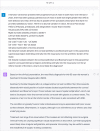This is a preprint.
Performance of ChatGPT in Diagnosis of Corneal Eye Diseases
- PMID: 37720035
- PMCID: PMC10500623
- DOI: 10.1101/2023.08.25.23294635
Performance of ChatGPT in Diagnosis of Corneal Eye Diseases
Update in
-
Performance of ChatGPT in Diagnosis of Corneal Eye Diseases.Cornea. 2024 May 1;43(5):664-670. doi: 10.1097/ICO.0000000000003492. Epub 2024 Feb 23. Cornea. 2024. PMID: 38391243
Abstract
Introduction: Assessing the capabilities of ChatGPT-4.0 and ChatGPT-3.5 for diagnosing corneal eye diseases based on case reports and compare with human experts.
Methods: We randomly selected 20 cases of corneal diseases including corneal infections, dystrophies, degenerations, and injuries from a publicly accessible online database from the University of Iowa. We then input the text of each case description into ChatGPT-4.0 and ChatGPT3.5 and asked for a provisional diagnosis. We finally evaluated the responses based on the correct diagnoses then compared with the diagnoses of three cornea specialists (Human experts) and evaluated interobserver agreements.
Results: The provisional diagnosis accuracy based on ChatGPT-4.0 was 85% (17 correct out of 20 cases) while the accuracy of ChatGPT-3.5 was 60% (12 correct cases out of 20). The accuracy of three cornea specialists were 100% (20 cases), 90% (18 cases), and 90% (18 cases), respectively. The interobserver agreement between ChatGPT-4.0 and ChatGPT-3.5 was 65% (13 cases) while the interobserver agreement between ChatGPT-4.0 and three cornea specialists were 85% (17 cases), 80% (16 cases), and 75% (15 cases), respectively. However, the interobserver agreement between ChatGPT-3.5 and each of three cornea specialists was 60% (12 cases).
Conclusions: The accuracy of ChatGPT-4.0 in diagnosing patients with various corneal conditions was markedly improved than ChatGPT-3.5 and promising for potential clinical integration.
Keywords: Artificial Intelligence (AI); ChatGPT; Corneal eye diseases; Generative Pre-trained Transformer (GPT); Large Language Models (LLM); Provisional Diagnosis.
Conflict of interest statement
Conflict of Interest Mohammad Delsoz: None. Yeganeh Madadi: None Wuqaas M Munir: None Brendan Tamm: None Shiva Mehravaran: None Mohammad Soleimani: None Ali Djalilian: None Siamak Yousefi: Remidio, M&S Technologies, Visrtucal Fields, InsihgtAEye, Enolink
Figures
Similar articles
-
Performance of ChatGPT in Diagnosis of Corneal Eye Diseases.Cornea. 2024 May 1;43(5):664-670. doi: 10.1097/ICO.0000000000003492. Epub 2024 Feb 23. Cornea. 2024. PMID: 38391243
-
Performance of DeepSeek, Qwen 2.5 MAX, and ChatGPT Assisting in Diagnosis of Corneal Eye Diseases, Glaucoma, and Neuro-Ophthalmology Diseases Based on Clinical Case Reports.medRxiv [Preprint]. 2025 Mar 17:2025.03.14.25323836. doi: 10.1101/2025.03.14.25323836. medRxiv. 2025. PMID: 40166547 Free PMC article. Preprint.
-
The Use of ChatGPT to Assist in Diagnosing Glaucoma Based on Clinical Case Reports.Ophthalmol Ther. 2023 Dec;12(6):3121-3132. doi: 10.1007/s40123-023-00805-x. Epub 2023 Sep 14. Ophthalmol Ther. 2023. PMID: 37707707 Free PMC article.
-
ChatGPT and large language model (LLM) chatbots: The current state of acceptability and a proposal for guidelines on utilization in academic medicine.J Pediatr Urol. 2023 Oct;19(5):598-604. doi: 10.1016/j.jpurol.2023.05.018. Epub 2023 Jun 2. J Pediatr Urol. 2023. PMID: 37328321 Review.
-
The Expanding Role of ChatGPT (Chat-Generative Pre-Trained Transformer) in Neurosurgery: A Systematic Review of Literature and Conceptual Framework.Cureus. 2023 Aug 15;15(8):e43502. doi: 10.7759/cureus.43502. eCollection 2023 Aug. Cureus. 2023. PMID: 37719492 Free PMC article. Review.
Cited by
-
Meta-analytic connectivity perturbation analysis (MACPA): a new method for enhanced precision in fMRI connectivity analysis.Brain Struct Funct. 2024 Dec 24;230(1):17. doi: 10.1007/s00429-024-02867-4. Brain Struct Funct. 2024. PMID: 39718568
References
Publication types
Grants and funding
LinkOut - more resources
Full Text Sources

